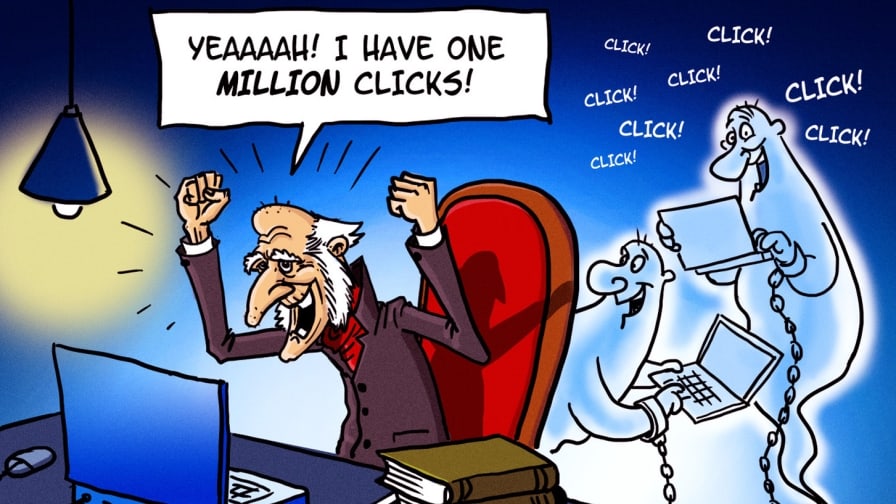Did you wake up after the big Cyber Week push feeling as miserable as Ebenezer Scrooge – thinking you could have squeezed a few more shillings from your display/retargeting budget? If your return on ad spend (ROAS) wasn’t as high as you hoped, it may be worth following in the footsteps of the ghosts of holiday marketing’s past and present to better plan for the future.
Don’t worry – no scary spirits will be pointing you towards your proverbial career grave in this visit. Instead, we’ll be taking a look at how the display/retargeting industry has evolved over the past few years and how you can take advantage of those changes to drive greater ROAS – even before the holiday season is over.
The Ghost of Holiday Marketing Past: Ads of the past were static, personalisation was limited, and we just didn’t have the sophisticated technology for reaching people that we have available today. Also, in those not-so-distant primitive days of online display, pay-per-click and view-through conversions were the best options available for measuring display campaigns. Now that technology has improved our campaigns and attribution is becoming increasingly important, giving us 20/20 hindsight, we can see the lack of insight and integrity these metrics brought to display media.
If you’re trying to compete in today’s market using yesterday’s technology, you might as well be Ebenezer trapped outside the party as the Ghost of Christmas Past forces you to examine where it first started to go wrong. If this sounds familiar, consider it a lesson learned and that you’re now ready to move on to the present.
The Ghost of Holiday Marketing Present: The most immediate and impactful change you can make now is to abandon the notion that clicks are the definitive be all and end all when it comes to determining customer interest and gauging campaign performance.
The reality is that focusing solely on clicks, leads to a false sense of accomplishment. After all, clicks have a low correlation with conversion, have no accountability for attribution, and are susceptible to fraudulent impressions.
Instead, focus on engagement as a way to gauge your performance and determine ROAS. One of the best strategies you can adopt in an engagement model is to only pay for the conversions that you can prove were influenced by the ad.
Of note, a recent comScore study proved engagement had the highest correlation with conversion. Essentially, the study showed that the most effective campaigns have an inclusionary optimisation strategy and create an engaging experience within the ads.
If you adopt an engagement strategy, you’ll be able to more effectively reach your entire audience of potential shoppers, particularly those that have traditionally been the hardest to convert.
But how exactly do you do that? Well, you already know the importance of personalisation and taking into account the type of holiday shoppers you’re trying to reach. For example, the uber planner and the procrastinator have wildly different shopping behaviours and timetables for completing their lists. Given this, your engaging in-ad offers should vary.
To further help put all of this into context, here are some of the best ways to engage customers in the coming weeks based on three of the most common holiday shopping scenarios:
- To influence lapsed shoppers, take advantage of CRM tools to reach out to former or less frequent customers. Done right, your campaign will serve as a reminder of positive past experiences while also providing gift suggestions for this holiday season. When you use CRM to better understand a customer’s buying history and combine that knowledge with your retargeting platform, you can present engaging ads and targeted emails that will boost conversions.
- To bring in-store shoppers online and better understand the impact of your online campaigns on offline sales, you’ll want to again look into combining CRM and retargeting. This will give you a distinct advantage by being able to serve more targeted ads that engage customers on the platform, website or social media channel of their choice while still protecting the anonymity of the shopper. However, in this CRM scenario, the primary goal is to support your O2O strategy by addressing the customer’s shopping preferences. These range from their desire to avoid the hustle and bustle at the mall in exchange for the luxury of late night shopping in their living room. To make the O2O experience easier and more meaningful to the customer, be sure to present offers such as free shipping and in-store return.
- To expand your reach to include shoppers who are buying for others, invest in search retargeting. As you do this, keep in mind that shoppers may not know exactly where to buy the gifts they’re looking for. They will be searching on broader categories, like designer handbags, boots or video games. Keep in mind that this is a great opportunity to get your brand and your deals in front of people who may not have you on their holiday shopping radar so you can acquire new customers this holiday shopping season.
The Ghost of Holiday Marketing Future: What does the future look like? While nobody knows for sure, here are three predictions based on past and current behaviour.
1. We will likely see more advances in technology designed to proactively thwart fraudulent click behaviour. When click numbers are too good to be true, we know to raise a flag, investigate, and blacklist those sites that thrive on nefarious behaviour.
2. There will be tighter integration and greater transparency among various digital marketing channels. As marketers continuously strive to drive higher ROAS, they’ll be looking to better understand the influences of the different yet complementary channels throughout the customer journey.
3. Advertisers that embrace transparency across their marketing channels and focus on engagement using the latest technologies will be rewarded with loyal customers. The biggest reason being that customers are becoming increasingly tech savvy and accustomed to personalised, targeted messages on the platform of their choice. Advertisers that fail to meet these requirements will not survive.
Just as Scrooge turned his life around overnight, it’s not too late to adjust your holiday marketing campaigns. By making changes now, you’re putting a solid foundation in place that will serve you well for the remainder of the season and long into the future.




